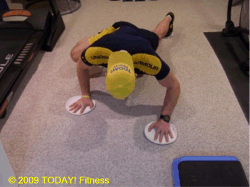|
Rope Jumping |
|
For
boxers, wrestlers, and many combat athletes... jumping rope is an
integral part of the workout routine. One of the primary reasons
for this is the high level of conditioning that is required for these
sports and the high effect that rope jumping has on the aerobic system.
Jumping rope is a
high-intensity exercise that builds aerobic and high intensity exercise
capacity. You can easily push heart rate to maximum if you turn
the rope as fast as you can. If you go slower, you still push
harder than when you jog with a friend. So, you get in shape
faster than you could running, swimming or cycling. Scientists
found that you work harder jumping rope than you do jumping in place or
jogging because you're concentrating on a skill and don't notice the
pain. Rope jumping is a great exercise because it improves fitness
quickly, develops fast, powerful legs and cuts fat.
Jumping rope is a simple, low-maintenance
activity. All you need is a good pair of shoes, a rope and a place
to jump. Choose shoes that absorb shock, such as cross-trainers or
tennis shoes that provide stability and cushioning under the balls of
your feet. Running shoes are not appropriate because they provide
poor lateral support.
Buy a rope that fits you - one that can move easily around your head and
body. A rope that's too long or too short will prevent fluid
movements. The rope is the right length when you can stand in the
middle of it and lift both ends up to your armpits. The rope
should turn easily in your hands and not bunch up around the handles.

You can jump rope almost anywhere.
Choose a well-lit area and a flat surface that isn't too hard.
Avoid hard concrete surfaces. Instead, choose a springy wooden
floor (gymnasium), artificial turf, or carpeted surface. Skipping
rope on a mat is dangerous because you can slip and get hurt badly.
Jump Rope Workout
Rope jumping is fairly intense exercise, so use interval training to
make it doable while still getting the benefits. Turn on some
music with a good rhythm that inspires you. Begin by jumping rope
for 15 to 30 seconds and then rest for 30 seconds. Turn the rope
slowly at first - about 120 turns per minute. As you become more
skilled and fit, build up to 140-160 turns per minute and extend the
time of each interval. A good workout is 15 sets of 1-minute rope
jumping with 1-minute rest between sets. Start off slowly and
build up. Jump rope for 30 minutes (including rest). Scale down the workout if it's too intense.
(Fitness Rx for Men - July 2008)
|
|
Stretching
Decreases Muscle Strength Power |
|
Pre-exercise stretching was
once part of the normal warm-up ritual of almost all strength, power,
and endurance athletes. Most fitness experts said that stretching
increased muscle and joint range of motion, which made movements easier
and reduced the risk of injury. It turns out that pre-exercise
stretching is a bad idea that decreases performance and increases the
risk of injury. Pre-exercise stretching reduces muscle strength
and power and interferes with the brain's ability to control the
muscles. Greek researchers found that muscle power decreases the
longer you stretch the muscle. They measured the effects of
stretches lasting from 10 seconds to 60 seconds on isometric strength
and power. Stretching for 30 seconds decreased isometric strength
by nearly 9 percent, while stretching 60 seconds decreased power by 16
percent. Stretching 30 seconds or longer has similar effects in
decreasing muscle power. They recommended that athletes avoid
static stretching of muscles for 30 seconds or more before activities
requiring maximum strength and power.
(Journal Strength Conditioning Research,
22: 40-46, 2008)
Keep in mind that this article is referring
to "stretching" only and has no reflection on warming up! It is
still recommended to warm up prior to resistance training with 5-10
minutes of light cardiovascular exercise, followed by a "light" set of
the exercise that you are doing (or similar movement) with reduced
weight.
|
|
Muscle Strength
Highest in the Afternoon |
|
What
is the best time of day to train? Most studies show that
muscle strength, power and endurance are greatest between about
4pm and 7pm. Muscle temperatures are generally highest at
this time, which probably accounts for the difference. A
study from Finland showed that daily variations in strength and
power cease to exist in people who train in the morning.
They examined 27 men who weight trained either in the morning
(7am to 9am) or in the afternoon (5pm to 7pm). Initially,
all subjects were stronger in the afternoon than in the morning.
But these differences disappeared in the morning training group,
but not in the evening training group. This study showed
that you should exercise in the morning if you have a morning
competition, because morning training will eliminate normal
strength differences between early and late times of day.
(Journal Sports Sciences,
June 12, 2008)
I used to wake up at
4:50am every day in order to squeeze in a workout between 5am
and 6am. As the article above described, it was very
challenging to start a routine like this. My energy was
not the greatest, and I definitely did not feel as strong at
first. It probably took me a week or so to get into the
swing of things, but exercising before my daughter woke up was
so much less stressful at the time... plus it kinda set the tone
for the day, giving me a sense of accomplishment. Hey, I
didn't say it was easy, and I like sleep as much as the next
person, but I made myself a promise and had to set the priority
to get it done. No excuses! |
|

|
|
|
Elite
Bodyweight Exercise of the Month! |
|
Plate
Climber

Summary:
My friend Bill told me about this one, so I had to try it.
He said, "Pete, I heard about this exercise that climbers use
with paper plates". I figured that it sounded crazy
enough to try, and it certainly was! You basically use 4
paper plates under your hands and feet so that you can slide
them easier on the carpet. This exercise is very close
to total body, although I would say that it primarily targets
your core, chest, and shoulders. Climbing an actual rock
wall is easier than this one!
Target:
abs, chest, shoulders (rectus abdominus, pectoralis major,
deltoids)
Count:
2 count
Description: Start in
a push-up position with your hands and feet each on a paper
plate. Alternate reaching forward with your left arm
while extending your left leg, and stepping with your right
leg so that your right elbow comes close to touching your
right knee. Then slide the plates while shifting to the
other side.
|
|
Senior Strength |
|
Recently I've had a few
questions regarding strength (resistance) training and muscle
growth with respect to seniors. This is a tricky
question to answer since I, for one, am NEVER going to admit
when I'm a senior! However, in the interest of answering
the question, I've done some research on the topic.
The simple answer to the
question is
"no matter how old you are, your body can still increase its
strength and muscle mass." Muscles are more important
than you may realize. For diabetics, more muscle means better
control of blood sugar. If osteoporosis is a concern, strength
training will not only preserve bone density, it will increase
it. If your health problems are made more serious by excess
weight, adding lean muscle to your body will increase the
number of calories your body burns, even while you are
resting, and will make it less convenient for you to store
body fat. That's just a sample of the reasons why strength
training should be at the foundation of any exercise program.
If you are
a senior, bodybuilding can be great for your health but also
for your heart and it just may help to prolong your life. Did
you know that men and woman who body build tend to look about
10 years younger, feel better and are more confident about
them selves?
Seniors build muscle just like
anybody else. Just because you may be a senior citizen
does not mean that you have to build muscle mass a certain
way.. you just may have to do it slower then younger people.
Of course if you have any health problems then you should
definitely go and see a doctor before starting any exercise
routine. Even if you are perfectly well you should most likely
visit your doctor and discuss with him your bodybuilding
goals. Remember safety first.
So how do you build muscle?
Well you need to lift enough weight to achieve muscle failure
this means that you need to lift with enough intensity and
enough weight to heat and break down your muscles and then
when they heal they will be stronger. This is how you build
muscle mass along with a high protein diet. You need to eat
one gram of protein per pound of body weight everyday. This is
a lot of protein but when it comes to protein supplements then
this is easily achievable. Vegetables are great for your body
as they help with the healing of muscles and fruits do pretty
much the same thing.
Everyone can reap the many health benefits that come from a
proper weight training program. Senior citizens may need to
exercise with a bit more caution, but will definitely be able
to tell a difference in the way they feel after starting such
a program.
I found a
really good article on Bodybuilding.com written by
John Pasco, a 74 year old
bodybuilder.
Click here to check it out.
How old is "too old"... I think that the question is really,
"when is it ok to be lazy"! That's a question that you
face your entire life!
|
|
It's
Go Time! |
|
I don't know about you, but I've
had just about enough of this cold weather already!
Don't get me wrong, I like my elliptical machine well enough
and I've been keeping up with my workouts, but it's
definitely not as easy to work up my motivation when it's
cold outside and gets dark early. Be that as it may,
ya gotta do what ya gotta do. If it's a priority, you
have to make time to make time for it! I talk to
people all the time that say, "I just don't enjoy working
out". Well, I've got news for you... I don't always
enjoy it either. Part of working out involves taking
your body out of it's comfort zone and challenging it to
improve. This involves some degree of stress on your
system, whether it be cardiovascular or resistance training
and stress is not something that is easy to like!
However, the sense of accomplishment after a workout and the
results that you begin to see long afterwards is well worth
the price of admission : )
Anyhow, I'm getting off the
subject... whether March comes in like a lion and goes out
like a lamb doesn't matter to me. I just want the
warmer weather now! For me that means cycling,
rollerblading, maybe some kayaking... there's plenty to do
and the warmer weather is awesome for that energy boost that
everyone needs!
For prior issues of this
newsletter go to
www.todayfitness.net/news.
Good Luck!
Pete
Mazzeo, CPT
pmazzeo@todayfitness.net
"OBSESSED:
Just a word the lazy use
to describe DEDICATED"
youtube video of the month -->
Sledgehammering
| |